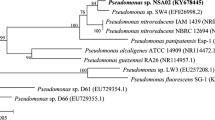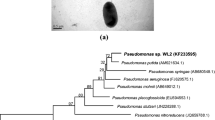Abstract
Following biodegradation tests according to the OECD guidelines for testing of chemicals 301F different degradation rates were observed for the three stereoisomers of iminodisuccinate (IDS). A strain was isolated from activated sludge, which used two of three isomers, R,S-IDS and S,S-IDS, as sole source of carbon, nitrogen, and energy. The isolated strain was identified by 16S-rDNA and referred to as Ralstonia sp. SLRS7. An IDS-degrading lyase was isolated from the cell-free extract. The enzyme was purified by three chromatographic steps, which included anion-exchange chromatography, hydrophobic interaction chromatography and gel filtration. The lyase catalysed the non-hydrolytic cleavage of IDS without requirement of any cofactors. Cleavage of S,S-IDS led to the formation of fumaric acid and L-aspartic acid. Interestingly R,S-IDS yielded only D-aspartic acid besides fumaric acid. R,R-IDS was not transformed. Thus, the IDS-degrading enzyme is a carbon–nitrogen lyase attacking only the asymmetric carbon atom exhibiting the S-configuration. Besides S,S-IDS and R,S-IDS cleavage, the lyase catalysed also the transformation of certain S,S-IDS metal complexes, namely Ca2+-, Mg2+- and Mn2+-IDS. The maximum enzyme activity was found at pH 8.0–8.5 and 35 °C. SDS-PAGE analysis revealed a single 57-kDa protein band. The native enzyme was estimated to be around 240 kDa indicating a homotetramer enzyme.
Similar content being viewed by others
References
Alder AC, Siegrist H, Gujer W & Giger W (1990) Behaviour of NTA and EDTA in biological waste water treatment. Water Res. 24: 733-742
Altschul SF, Madden TL, Schäffer AA, Zhang J, Zhang Z, Miller W & Lipman DJ (1997) Gapped Blast and PSI_Blast: a new generation of protein database search programs. Nucl. Acids Res. 25:3389-3402
Bayer AG (1998) —IDS Na-Salz. Eine neue umweltfreundliche Alternative zu klassischen Komplexierungsmitteln. Brochure of Bayer, Leverkusen, Germany
Bayer AG (2001) Safety Data Sheet 857037/10 of Bayer, Leverkusen, Germany
Bayer AG (2002) Safety Data Sheet 699229/04 of Bayer, Leverkusen, Germany
Bradford MM (1976) A rapid and sensitive method for the quanti.cation of microgram quantities of proteins utilizing the principle of protein-dye binding. Anal. Biochem. 72: 248- 254
Bucheli-Witschel M & Egli T (2001) Environmental fate and microbial degradation of aminopolycarboxylic acids. FEMS Microbiol. Lett. Rev. 25: 69-106
Einarsson S & Josefsson B (1987) Separation of amino acid enantiomers and chiral amines using precolumn derivatization with (+)-1-(9-.uorenyl)ethylchloroformate and reversed-phase liquid chromatography. Anal. Chem. 59: 1191-1195
Gardiner J (1976) Complexation of trace metals by ethylenediaminetetraacetic acid (EDTA) in natural waters. Water Res. 10: 507-514
Kari FG & Giger W (1996) Speciation and fate of ethylenediaminetetraacetate in municipal wastewater treatment. Water Res. 30: 122-134
Kari FG, Hilger SU & Cannonica S (1995) Determination of the reaction quantum yield for the photochemical degradation of Fe(III)-EDTA - implications for the environmental fate of EDTA in surface waters. Environ. Sci. Technol. 29: 1008-1017
Lämmli UK (1970) Cleavage of structural proteins during the assembly of the head of bacteriophage T4. Nature (London) 227: 680-685
Lau. JJ, Steele DB, Coogan LA & Breitfeller JM (1990) Degradation of the ferric chelate of EDTA by a pure culture of an Agrobacterium sp. Appl. Environ. Microbiol. 56: 3346- 3353
Means JL & Alexander CA (1981) The environmental biogeochemistry of chelating agents and recommendations for the disposal of chelated radioactive wastes. Nucl. Chem. Waste Manag. 2: 183-196
Means JL, Crerar DA & Duguid JO (1978) Migration of radioactive wastes: radionuclide mobilization by complexing agents. Science 200: 1477-1481
Nishikiori T, Okuyama A, Naganawa T, Takita T, Hamada M, Takeuchi T, Aoyagi T & Umezawa H (1984) Production by actinomycetes of (S,S)-N,N¢-ethylenediamine-disuccinic acid, an inhibitor of phospholipase C.J. Antibiot. 37: 426- 427
Nörtemann B (1992) Total degradation of EDTA by mixed cultures and a bacterial isolate. Appl. Environ. Microbiol. 58: 671-676
Nörtemann B (1999) Biodegradation of EDTA. Appl. Microbiol. Biotechnol. 51: 751-759
Pfennig N & Lippert KD (1966) Ñber das Vitamin B12-Bedürfnis phototropher Schwefelbakterien. Arch. Mikrobiol. 55: 245-256
Reinecke F, Groth T, Heise KP, Joentgen W, Müller N & Steinbüchel A (2000) Isolation and characterization of an Achromobacter xylosoxidans strain B3 and other bacteria capable to degrade the synthetic chelating agent iminodisuccinate. FEMS Microbiol. Lett. 188: 41-46
OECD (1993) Guidelines for Testing of Chemicals. The OECD Expert Group on Degradation and Accumulation. Ready Biodegradability: 301F Manometric Respirometry Test. Organization for Economic Cooperation and Development. Paris, France
Schowanek D, Feijtel TC, Perkins CM, Hartmann FA, Federle TW & Larson RJ (1997) Biodegradation of [S,S], [R,R] and mixed stereoisomers of ethylene diamine disuccinic acid (EDDS), a transition metal chelator. Chemosphere 34: 2375-2391
Shevchenko A, Wilm M, Vorm O & Mann M (1996) Mass spectrometric sequencing of proteins from silver-stained polyacrylamide gels. Anal. Chem. 68: 850-858
Siegrist H, Alder A, Gujer W & Giger W (1988) —Verhalten der organischen Komplexbildner NTA und EDTA in Belebungsanlagen. Wasser - Abwasser 68: 101-109
Uetz T, Schneider R, Snozzi M & Egli T (1991) Purification and characterization of a two-component monooxygenase that hydroxylates nitrilotriacetate from Chelatobacter strain ATCC 29600. J. Bacteriol. 174: 1179-1188
Witschel M & Egli T (1998) Purification and characterization of a lyase from the EDTA-degrading bacterial strain DSM 9103 that catalyses the splitting of [S,S]-ethylenediaminedisuccinate, a structural isomer of EDTA. Biodegradation 8: 419- 428
Witschel M, Nagel S & Egli T (1997) Identification of the twoenzyme system catalyzing oxidation of EDTA in the EDTA degrading bacterial strain DSM 9103. J. Bacteriol. 179: 6937- 6943
Witschel M, Egli T, Zehnder AJB, Wehrli E & Spycher M (1999) Transport of EDTA into cells of the EDTA-degrading bacterial strain DSM 9103. Microbiology 145: 973-983
Author information
Authors and Affiliations
Rights and permissions
About this article
Cite this article
Cokesa, Ž., Lakner, S., Knackmuss, HJ. et al. A Stereoselective Carbon-Nitrogen Lyase from Ralstonia sp. SLRS7 Cleaves Two of Three Isomers of Iminodisuccinate. Biodegradation 15, 229–239 (2004). https://doi.org/10.1023/B:BIOD.0000042903.04718.f6
Issue Date:
DOI: https://doi.org/10.1023/B:BIOD.0000042903.04718.f6




